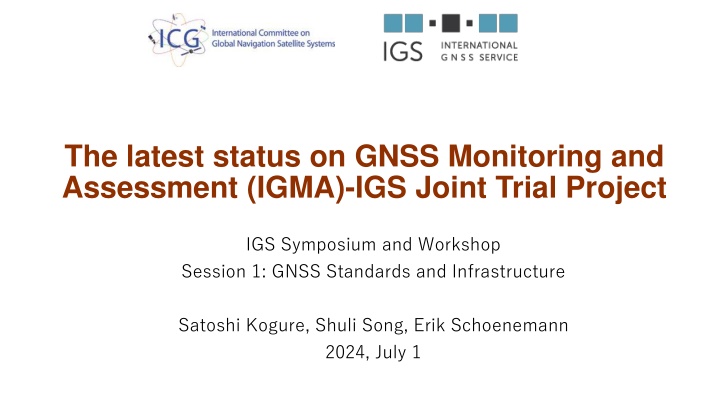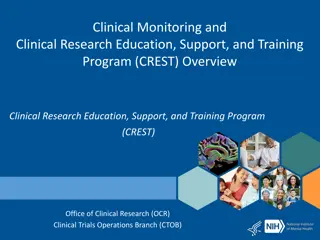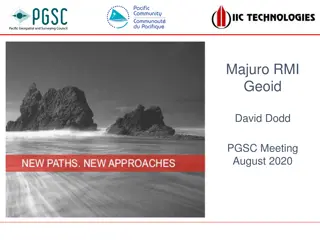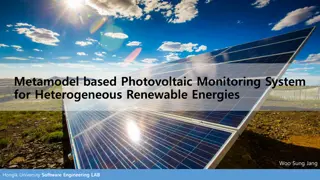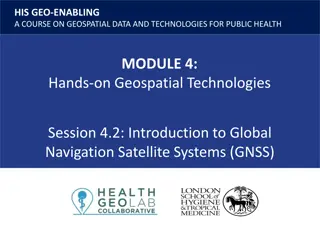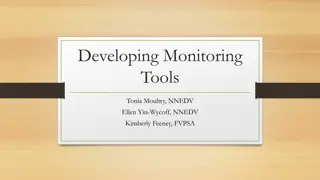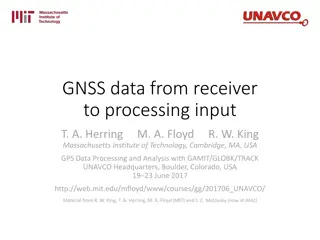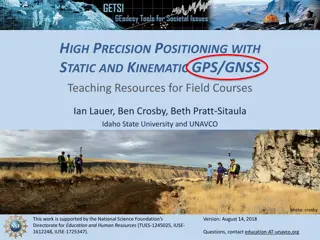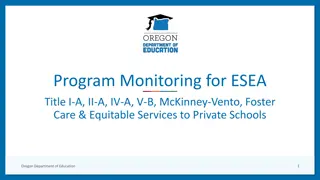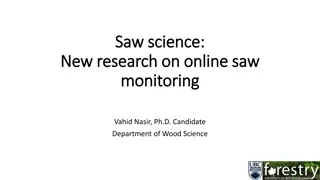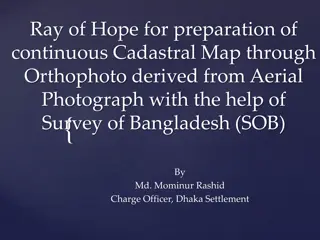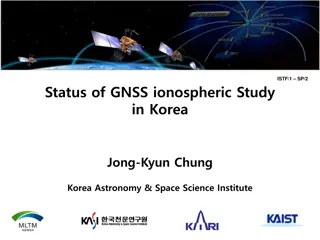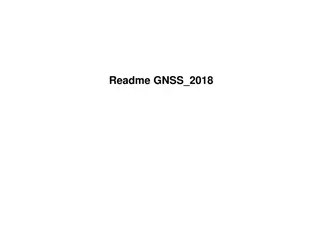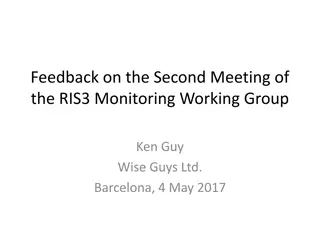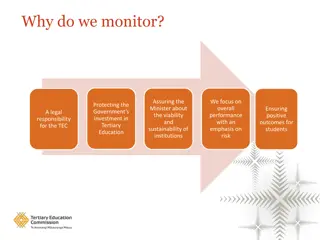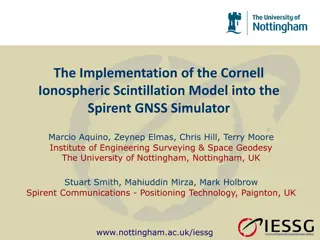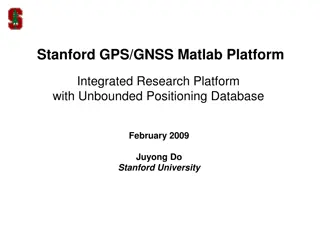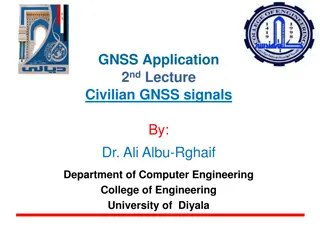Latest Status on GNSS Monitoring and Assessment
This document provides insights into the IGMA-IGS Joint Trial Project, focusing on GNSS standards and infrastructure. It covers the project's concept, objectives, progress, future roadmap, and expected contributions. The phased approach, utilization of existing infrastructure, and framework are detailed.
Download Presentation

Please find below an Image/Link to download the presentation.
The content on the website is provided AS IS for your information and personal use only. It may not be sold, licensed, or shared on other websites without obtaining consent from the author.If you encounter any issues during the download, it is possible that the publisher has removed the file from their server.
You are allowed to download the files provided on this website for personal or commercial use, subject to the condition that they are used lawfully. All files are the property of their respective owners.
The content on the website is provided AS IS for your information and personal use only. It may not be sold, licensed, or shared on other websites without obtaining consent from the author.
E N D
Presentation Transcript
The latest status on GNSS Monitoring and Assessment (IGMA)-IGS Joint Trial Project IGS Symposium and Workshop Session 1: GNSS Standards and Infrastructure Satoshi Kogure, Shuli Song, Erik Schoenemann 2024, July 1
Topics 1. IGMA ICG-IGS joint Trial Project (JTP) Concept, and past activities 2. Latest Status on the JTP I. ToR revision II. Progress on the preparation of the 2ndcalculation run III. Restarting IGS MAC activity (IGS Monitoring WG) 3. Future Roadmap 4. Expected IGS Contributions 2
1. IGMA ICG-IGS joint Trial Project IGMA-IGS Joint Trial Project (JTP) was launched in 2016 under joint effort between International Committee on GNSS (ICG) and International GNSS Service (IGS), in accordance with ICG-10 recommendation (10A/D.4.1). The major objectives is to establish GNSS performance monitoring and assessment scheme with trust and reliable manner under international collaboration. The JTP was the first step of creating such scheme, infrastructure and joint working structure to demonstrate user benefits of consolidated monitoring system products, and combined use of multi-constellations. The fundamental four performance parameters, orbit and clock error, Signal In Space Ranging Error (SISRE), UTC Offset Error (UTCOE) and PDOP, were selected as a set of evaluated parameter as well as post process calculation methodology at the early stage of the JTP.
1. IGMA ICG-IGS joint Trial Project Concept Phased approach: Start as simpler as possible Phase I Post Processing System level performance monitoring with limited parameters for each single constellation Post-processing to real time processing, e.g. archived data to real-time observation at the actual site + User level performance monitoring Future Expansion +Real-time Processing System level performance parameters to user level parameter + Assessment function Single constellation s performance to Multiple constellation s performance + multi-GNSS performance monitoring and assessment
1. IGMA ICG-IGS joint Trial Project Concept (Cont.) Utilization of the existing infrastructure and capabilities: Collaborating with IGS, Chinese iGMAS, Japanese MGM Net who were operating multi-GNSS tracking network around 2015 POD Capabilities
1. IGMA ICG-IGS joint Trial Project Framework ToR defines objectives, tasks and working structure. IGMA TF is lead by both ICG and IGS representatives, and a connecting point. Implementation in IGS side is being done by IGS Monitoring and Assessment WG. US, EC, Russia and China nominated their MACs formally, Japan and India expressed interests in participations. Terms of Reference for IGMA-IGS joint Trial Project IGMA Task Force IGS ICG Providers Charter for IGS GNSS Monitoring Working Group Implementation Document for IGMA IGS joint Trial Project MAC selected through CfP through CfP through CfP through CfP MAC Galileo Reference Centre MAC Volpe center/DOT MAC MAC RISM /NTSC MAC selected MAC selected MAC(or AAC) selected PNT Center / TSNIMASH nominated by GPS nominated by GLONASS nominated by GALILEO nominated by BDS MAC MAC MACC which generates combined product nominated by QZSS nominated by NavIC ICG User Community
1. IGMA ICG-IGS joint Trial Project Major steps (until 2019) 2015: 1st IGMA workshop in Xian 2016: ICG-10, Rec 10A/D recommended to launch JTP Terms for Reference established, CfPs were issued IGS Governing Board meeting on Dec. 10, 2016, decided IGS participation into JTP 2017: 2nd IGMA workshop, May in Shanghai and IGS workshop, July in Paris IGS Pilot Project was initiated, preliminary trial were carried out 2018: 3rd IGMA workshop, May in Noordwijk Discussed methodologies which each provider were calculating parameters 2019: 4th IGMA workshop, June in Vienna The first calculation results exchange was conducted and found some inconsistencies among results. Recognized common methodology for the parameters calculation.
1. IGMA ICG-IGS joint Trial Project Major steps (after 2020) 2020 - : Continuous Monthly meetings Creating ICG IGMA-IGS JTP Calculation Methodology document and data exchanging format 2024: 5th IGMA workshop, Jan in Chiang Rai Date: January 29 and 30, 2024 Venue: Mae Fah Luang University, Chiang Rai Participation: China, EU, Japan, Russia, U.S. and IGS Major Topics: Final approval of the IGMA-IGS Joint Trial Project ToR Discussion of plans for the Trial Run 2 Harmonization of calculation methodologies for the Trial Run 2 Data exchange format, Sample File Update of IGMA Roadmap
2. Latest Status on the JTP I. ToR revision After review in IGS, all minor modifications were accepted by TF members. The updated ToR was completely adopted. Major changes on the revised ToR are followings, - It limited to administrative and strategic items. Technical and mathematical details were described in the separate document, ICG IGMA-IGS JTP Calculation Methodology . - Parameters definitions in the Appendix I were simplified and left the definition would be used in the first stage of JTP. - ISRO, Indian NavIC provider, announced their intention to join the JTP. The placeholder describing future their participation are updated. Handling of appendices were agreed that they are subject to change separating from main body of the ToR. - List of participants, organizations, monitoring sites, and short term milestones
Structure change of the ToR Main body Main body Annex I Annex I Definition of parameters Definition of parameters Annex II Separate document Methodology of monitored parameters ICG IGMA-IGS JTP Calculation Methodology Annex III Separate document Roadmap for IGMA Roadmap for IGMA-IGS Joint Trial Project Annex IV Annex II GNSS reference documents for observation/calculation of monitored parameters Reference documents Annex V Annex III List of TF members, Participants and Point of Contact List of TF members, Participants and Point of Contact Annex VI Annex IV Milestones of Trial Project Milestones of Trial Project Annex V Change Record Annex VII Change Record
2. Latest Status on the JTP II. Progress on the preparation of the 2nd calculation run Evaluation period The calculation period for the TR2 was decided as follow; - Orbit and Clock errors, SISRE and PDOP: One-month period from August 1 to August 31, 2022 - UTCOE: Same as other three parameters, but one-year period data from August 2, 2021 to Aug 31, 2022 for calculating UTCOE statistical value.
2. Latest Status on the JTP II. Progress on the preparation of the 2nd calculation run Common Calculation Methodology ICG IGMA-IGS JTP Calculation Methodology is ongoing, close to finalizing. PDOP: Completely done Orbit and Clock errors, and SISRE: Partially(e.g. Orbit error) harmonized, Clock part need some contributions Reference data set for SISRE, orbit and clock errors at the TR2 were agreed on use of independent reference provided by each provider or existing IGS final. UTCOE: need further discussion
2. Latest Status on the JTP II. Progress on the preparation of the 2nd calculation run Data exchange format, Sample File Discussing that extracted items should be included in the filename or inside the file as meta data or header, otherwise defined in the methodology document. For instance, - File type (.oac, .ure, etc. ) should be in the filename. - Time stamp of individual record (2020720 00:00:00) should be inside of file. - Grid points for PDOP calculation should be in the calculation methodology document. Sample file will be provided for code development.
2. Latest Status on the JTP II. Progress on the preparation of the 2nd calculation run Schedule More feasible schedule for 2nd Calculation Run is still being discussed. - Finalizing the Common Methodology document, and data exchange file format will be completed until the coming ICG-18, October 2024. - Confirming data archive for the 2nd calculation run will be done by ICG-18. - The 2nd calculation run will be conducted after ICG-18 before the next IGMA/PS workshop in early 2025. The calculation result exchange and discussion will be major agenda item for the workshop Candidate MGA conference 2025, Phuket, Thailand - Report to ICG will be submitted at ICG-19.
2. Latest Status on the JTP III. Restarting IGS MAC activity (IGS Monitoring WG) The IGS monitoring pilot project activities have been restarted by the end of last year. The second call for participation for IGS monitoring Pilot Project, contributing the JTP was conducted at the beginning of this year. - 13 organizations responded 5 applied as IGS MAC New IGS MAC setup is ongoing - first IGS internal comparisons have been performed.
3. Future Roadmap Redefined future roadmap during the 5th workshop Phase Parameters and methods Tasks Phase I - 2024 (ICG-18) Four parameters (system level) for each single constellation Post processing Consistent output with harmonized methodologies 1st Calculation Run Creation of Methodology Doc and Data exchange format Doc 2nd Calculation Run Report to ICG Phase II - 2025 (ICG-19) User level parameters such as positioning, velocity, and timing accuracy. Post processing Creation of Methodology Doc and Data exchange format Doc for additional parameters Finalization of Monitoring Site Specification Doc 1 or 2 Calculation Runs Report to ICG Phase III - 2027 (ICG-21) Combined solutions with multiple constellations Post Processing Creation of Methodology Doc and Data exchange format Doc for multiple constellation Monitoring Site Establishemnt 1 or 2 Calculation Runs Report to ICG Phase IV - 2029 (ICG-23) Real time monitoring and assessment, each independent constellation monitoring first, then multiple constellation s one. Creation of Methodology Doc and Data exchange format Doc 1 or 2 Calculation Runs Report to ICG
IGMA JTP Roadmap Beyond 2024 Updated as of June 2024 ICG-23 in 2029 Add real-time monitoring Phase IV Combined multiple constellation ICG-22 in 2028 Independent constellation s performance monitoring ICG-21 in 2027 Combined solutions with multiple constellations (Post Processing) Phase III Providing JTP Phase III report to ICG Completion of MS set up ICG-20 in 2026 Harmonizing methodologies for real-time monitoring Data set period set-up ICG-19 in 2025 Phase II Add new parameters User level parameters such as positioning, velocity, and timing accuracy. Providing JTP Phase II report to ICG MS site specification finalized Harmonizing methodologies for new parameters Data set period set-up Long term goal: Proof of real-time performance monitoring and evaluation result dissemination ICG-18 in 2024 Providing JTP Phase I report to ICG
4. Expected IGS Contributions Review the prepared documents by IGMA TF and return feedbacks Participating into the next IGMA workshop in early 2025 Provision of calculation result as one of MACs, but well evaluated than each single provider. Multi-constellation s orbit and clock reference IGS Network and site guideline
Thanks for your attention Question?
